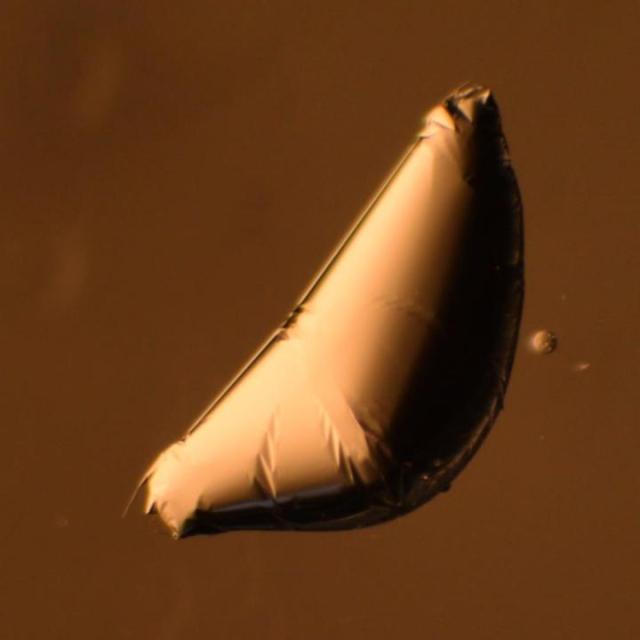Researchers at the University of Massachusetts Amherst have utilized very thin sheets to encapsulate droplets of one fluid within another.
 UMass Amherst materials researchers recently proposed and validated a model of wrapped shapes used to encapsulate one fluid droplet within another. Shown is a 39 nm sheet, radius 1.52 mm, and water drop in silicone oil floating on fluorinated oil. (Courtesy UMass Amherst/Joseph Paulsen)
UMass Amherst materials researchers recently proposed and validated a model of wrapped shapes used to encapsulate one fluid droplet within another. Shown is a 39 nm sheet, radius 1.52 mm, and water drop in silicone oil floating on fluorinated oil. (Courtesy UMass Amherst/Joseph Paulsen)
Conventionally, soap molecules or micro- or nano-particles are used for encapsulating fluid droplets within another droplet. A thin sheet is used for wrapping droplets based on its capillary action. The sheet has to be bent around the drop and this requires a certain amount of force. This force has been considered as a limiting factor to the achievements possible in this process.
In this study, the research team including experimental physicist Narayanan Menon; theoretical physicists Benjamin Davidovitch, Christian Santangelo, and Vincent Démery; polymer scientist Thomas Russell; and postdoctoral researcher Joseph Paulsen.
For the wrapping, they used comparatively thinner sheets than what had been used in earlier processes. Menon stated that these thin sheets helped address these constraints and enabled a new class of wrapped shapes. He added that these wrapping techniques could be utilized for numerous purposes, including shrink-wrapping of drops, isolating delicate liquid cargo physically, and for containing corrosive or toxic liquids.
A novel process was devised by Paulsen. A flat sheet with a circular shape was placed over a drop. A thin straw was used to remove fluid from the droplet, which led to gradual decrease in its volume. This caused the sheet completely wrap the droplet with minor wrinkling and crumpling.
The group observed that when a very thin skin was used, a non-spherical shape was formed. Typically, the sheet was expected to match the drop’s spherical shape. “These non-spherical shapes are reminiscent of foods in which a filling is wrapped inside a sheet of pastry or dough, such as a samosa, an empanada or a dumpling,” says Menon.
A general model was developed by the theorists that explained.
All the observed partially and fully wrapped shapes purely geometrically, independent of material parameters, in a regime of thickness that often occurs in nature and is easily achieved in technological settings. Wrinkles, fold and crumples are challenging to understand on their own, let alone when they interact in a highly-curved geometry. However, we show that the essence of the wrapping process can be understood without describing any small-scale features.
Paulsen adds, “We’ve shown that for very thin sheets, you can ignore the complicated small-scale features and still predict the overall three-dimensional shape of the wrapping.”
This study has led to three significant advantages. The first advantage is that when ultrathin sheets are used for wrapping, they automatically choose a wrapping method that minimizes wastage of material for wrapping fluids. “This corresponds to satisfying the goal of everyone who has wrapped a gift using the least amount of wrapping paper possible,” he says.
The second advantage is that the new method enables greater functionality, as the sheet’s mechanical properties, and the energies that exist at the droplet-wrapper interface are not relevant. The greater functionality allows sheets with different properties to be used, without affecting the process.
The third advantage is that even without any specially designed sheets, the fluid can be covered completely.
Special sheet designs are possible, but if you are trying to do this on a large scale, then it is tedious to make sheets that are cut in some complicated way so they can fold up easily. Thin enough sheets automatically wrinkle and fold in such a way that you don’t need to cut them up.
Menon
Paulsen says, “We expect our findings to be useful in applications where a liquid cargo needs to be protected in a solid barrier. Our main focus was on shape, but we expect these wrapped droplets to have interesting mechanical properties as well.”
The study paper has been published online in the journal, Nature Materials.
The Keck Foundation has provided funding for this study.
References